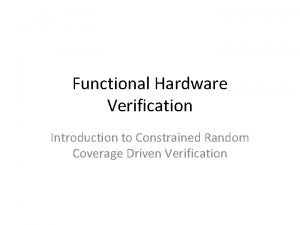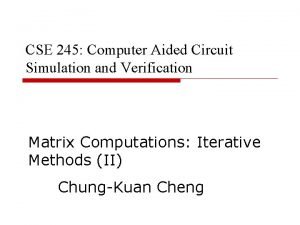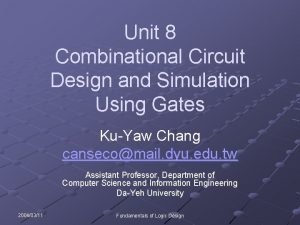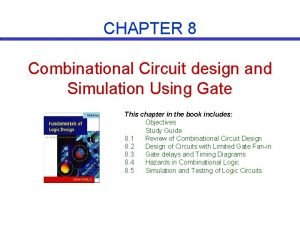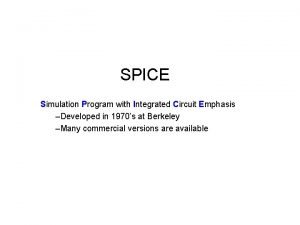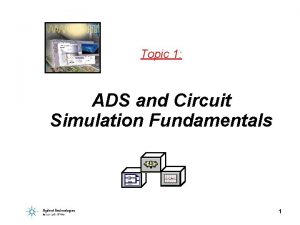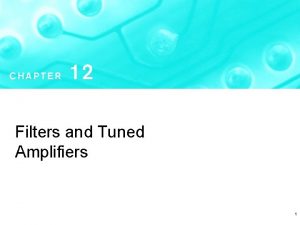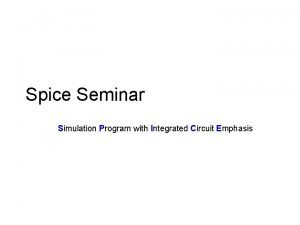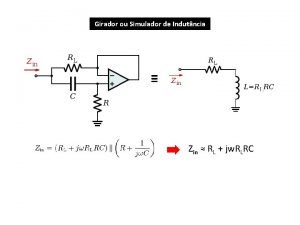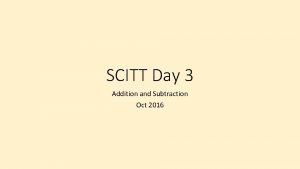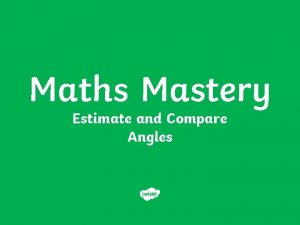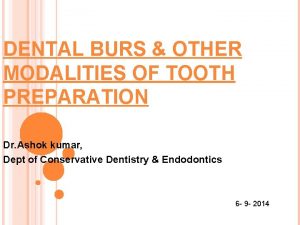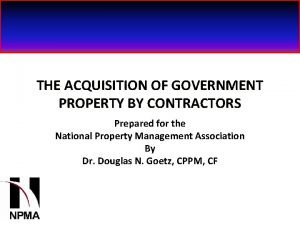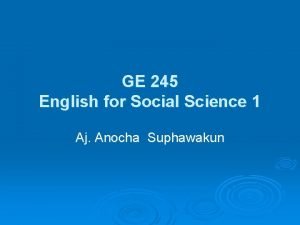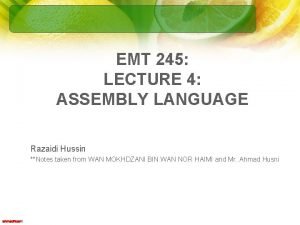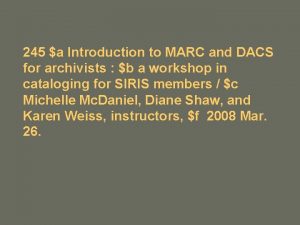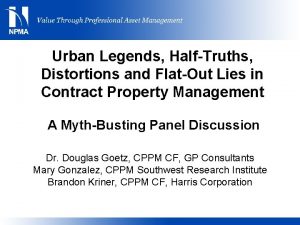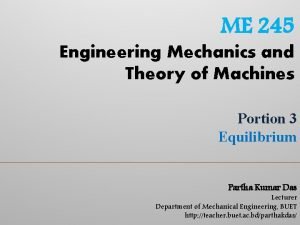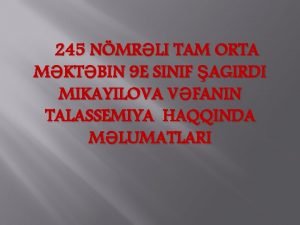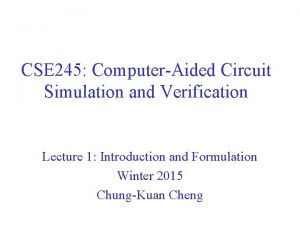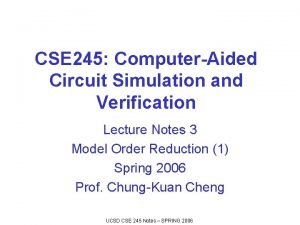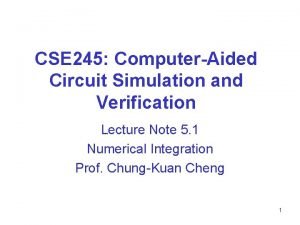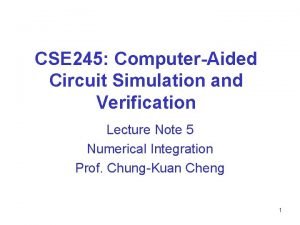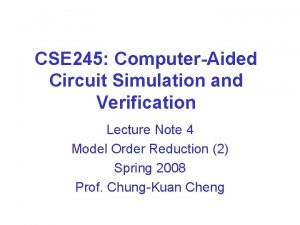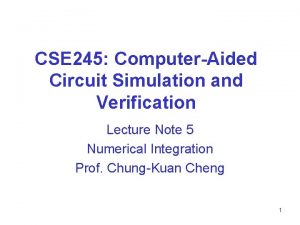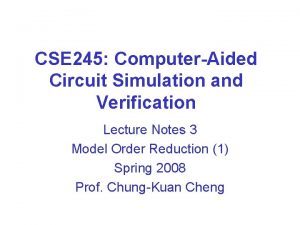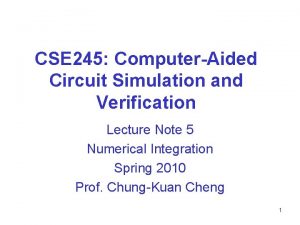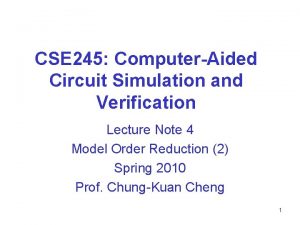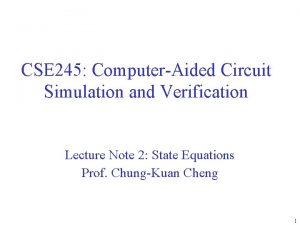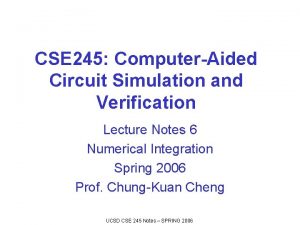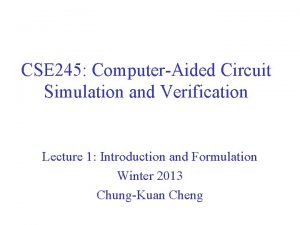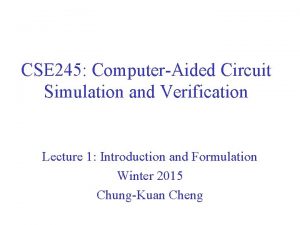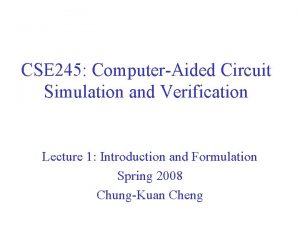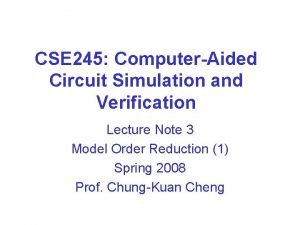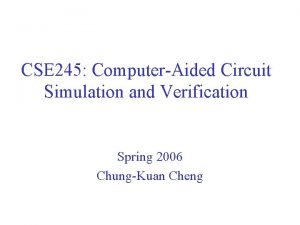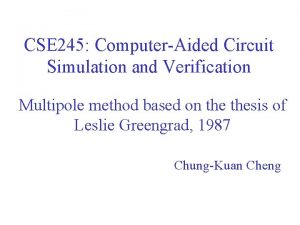CSE 245 ComputerAided Circuit Simulation and Verification Lecture






















- Slides: 22

CSE 245: Computer-Aided Circuit Simulation and Verification Lecture Note 2: State Equations Spring 2010 Prof. Chung-Kuan Cheng

State Equations 1. 2. 3. 4. Motivation Formulation Analytical Solution Frequency Domain Analysis 5. Concept of Moments

Motivation • Why – Whole Circuit Analysis – Interconnect Dominance • Wires smaller R increase • Separation smaller C increase • What – Power Net, Clock, Interconnect Coupling, Parallel Processing • Where – – Matrix Solvers, Integration For Dynamic System RLC Reduction, Transmission Lines, S Parameters Whole Chip Analysis Thermal, Mechanical, Biological Analysis

Formulation • General Equation (a. k. a. state equations) • Equation Formulation – Conservation Laws • KCL (Kirchhoff’s Current Law) – n-1 equations, n is number of nodes in the circuit • KVL (Kirchhoff’s Voltage Law) – m-(n-1) equations, m is number of branches in the circuit. – Branch Constitutive Equations • m equations

Formulation State Equations (Modified Nodal Analysis): Desired variables 1. Capacitors: voltage variables 2. Inductors: current variables 3. Current controlled sources: control currents 4. Controlled voltage sources: currents of controlled voltage sources. Freedom of the choices 1. Tree trunks: voltage variables 2. Branches: current variables

Conservation Laws • KCL n-1 independent cutsets • KVL m-(n-1) independent loops

Branch Constitutive Laws • Each branch has a circuit element – Resistor – Capacitor v=R(i)i i=dq/dt=C(v)dv/dt • Forward Euler (FE) Approximation • Backward Euler (BE) Approximation • Trapezoidal (TR) Approximation – Inductor • Similar approximation (FE, BE or TR) can be used for inductor.

Branch Constitutive Laws Inductors v=L(i)di/dt Mutual inductance V 12=M 12, 34 di 34/dt

Formulation - Cutset and Loop Analysis • Select tree trunks and links • find a cutset for each trunk – write a KCL for each cutset matrix • find a loop for each link – write a KVL for each loop matrix

Formulation - Cutset and Loop Analysis • Or we can re-write the equations as: • In general, the cutset and loop matrices can be written as

Formulation – State Equations • From the cutset and loop matrices, we have • Combine above two equations, we have the state equation • In general, one should – Select capacitive branches as tree trunks • no capacitive loops • for each node, there is at least one capacitor (every node actually should have a shunt capacitor) – Select inductive branches as tree links • no inductive cutsets

Formulation – An Example Output Equation (suppose v 3 is desired output) State Equation

Responses in Time Domain • State Equation • The solution to the above differential equation is the time domain response • Where

Exponential of a Matrix • Calculation of e. A is hard if A is large • Properties of e. A • k! can be approximated by Stirling Approximation • That is, higher order terms of e. A will approach 0 because k! is much larger than Ak for large k’s.

Responses in Frequency Domain: Laplace Transform • Definition: • Simple Transform Pairs • Laplace Transform Property - Derivatives

Responses in Frequency Domain • Time Domain State Equation • Laplace Transform to Frequency Domain • Re-write the first equation • Solve for X, we have the frequency domain solution

Serial Expansion of Matrix Inversion • For the case s 0, assuming initial condition x 0=0, we can express the state response function as • For the case s , assuming initial condition x 0=0, we can express the state response function as

Concept of Moments • The moments are the coefficients of the Taylor’s expansion about s=0, or Maclaurin Expansion • Recall the definition of Laplace Transform • Re-Write as • Moments

Concept of Moments • Re-write Maclaurin Expansion of the state response function • Moments are

Moments Calculation: An Example

Moments Calculation: An Example • A voltage or current can be approximated by • For the state response function, we have

Moments Calculation: An Example (Cont’d) • (1) Set Vs(0)=1 (suppose voltage source is an impulse function) • (2) Short all inductors, open all capacitors, derive Vc(0), IL(0) • (3) Use Vc(i), IL(i) as sources, i. e. Ic(i+1)=CVc(i) and VL(i+1)=LIL(i), derive Vc(i+1), IL(i+1) • (4) i++, repeat (3)
 Constrained random verification
Constrained random verification Cse simulation oy
Cse simulation oy 01:640:244 lecture notes - lecture 15: plat, idah, farad
01:640:244 lecture notes - lecture 15: plat, idah, farad Combinational circuit design and simulation using gates
Combinational circuit design and simulation using gates Combinational circuit design
Combinational circuit design Spice (simulation program with integrated circuit emphasis)
Spice (simulation program with integrated circuit emphasis) Ads circuit simulation
Ads circuit simulation Bridged t network transfer function
Bridged t network transfer function Microwave simulation software
Microwave simulation software Simulation program with integrated circuit emphasis
Simulation program with integrated circuit emphasis Circuito de antoniou
Circuito de antoniou Use a number line to solve 245-137
Use a number line to solve 245-137 245 angle
245 angle 245 prime factors
245 prime factors Burs used in crown preparation
Burs used in crown preparation Far 52-245-1
Far 52-245-1 Aj 245
Aj 245 Emt 245
Emt 245 200 yuvarlanan sayılar
200 yuvarlanan sayılar Marc 245
Marc 245 Far52.245-1
Far52.245-1 Meyb-245
Meyb-245 245 nömrəli tam orta məktəb
245 nömrəli tam orta məktəb
